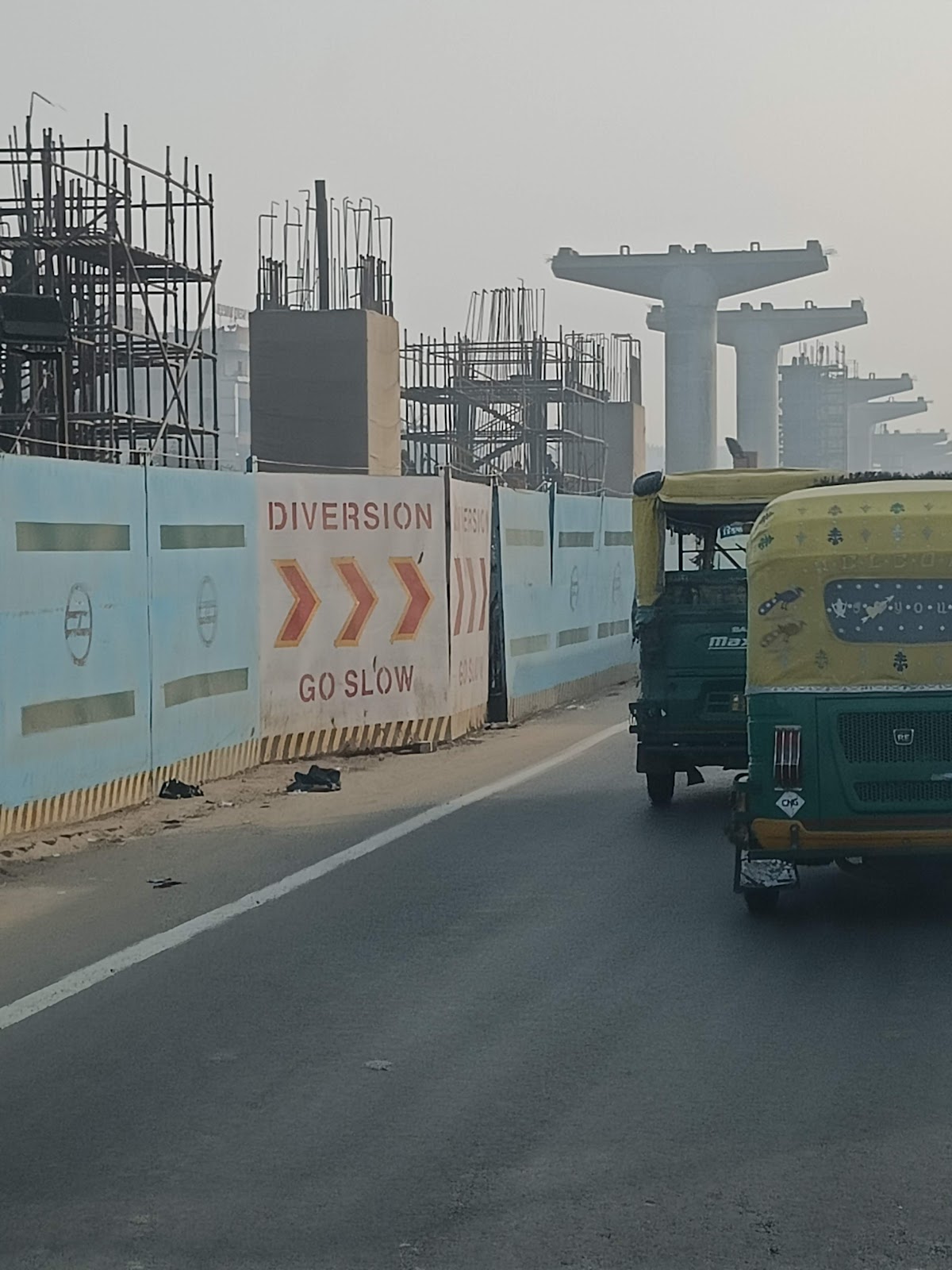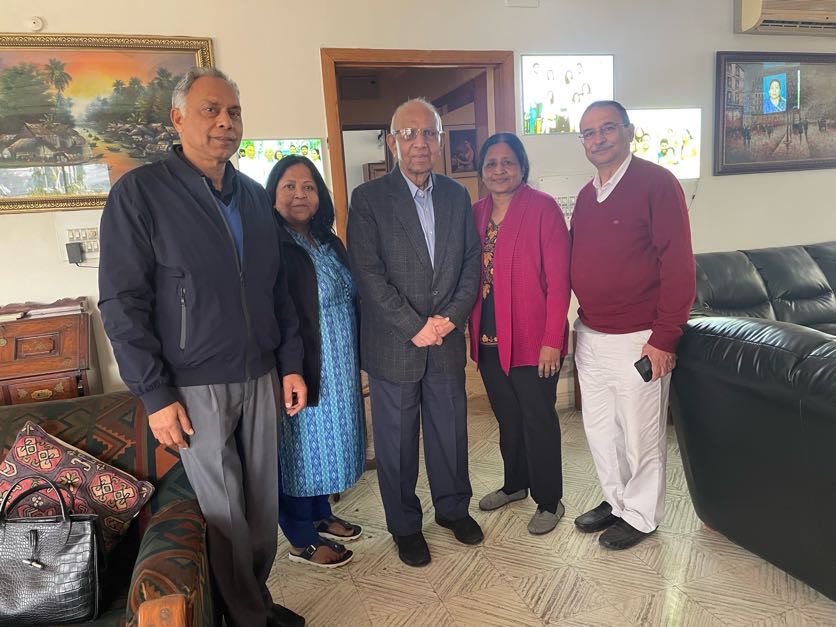Our Samdhis (Dilip and Shrimi Sinha and Shrimi's father Dr HRP Varma) are from Patna and when they suggested that we join them there in January, we jumped at the opportunity. I hadn't visited Patna for years and anyway the last few trips time had been for work so there had been no time to visit any of the historical and cultural sites. I had a faint recollection of my Chachi's father's house in Danapur when I had visited as a child. So all in all, it was going to be a new experience.
Day1
The flight to Patna was on Indigo. Landed on time at Patna. We had to walk to the terminal building which was a bit of a downer. There does seem to be a new terminal coming up but I heard that expansion in the current site is not going to be very easy. The airport could do with a facelift. However baggage arrived soon enough and we exited. The drive home was through some of the British built parts of Patna. The roads were good - broad and smooth and the buildings were impressive. It reminded me a little of Lucknow. There is a metro under construction too.

After lunch we set off to the Bihar Museum. This is a very impressive new structure. It has been designed by a Japanese firm, and the building and the exhibits are world class. Since it is focused on Bihar, the exhibits take on a more immediate, local appeal. The growth and development of the dynasties, rulers and religious and spiritual leaders in Bihar is very well presented dating back to the Nandas and the Mauryas. The pride of place undoubtedly goes to the Didarganj Yakshi. This magnificent statue dates to Mauryan times and was being used as a Dhobi's stone till it was rescued!
After the museum visit, we had coffee and pakoras at the museum café - It's called Potbelly and is a part of the chain that has outlets in Gurgaon and Delhi. Their chutneys are interesting - one was made of Parwal that we had not tasted before.
After the museum visit, we went for a drive on Patna's Marine Drive. This is still being developed rather along the lines of Lucknow but as a famous courtesan in the 19th Century from Kanpur once said in defence of her hometown, 'Aakhir Gomti ko Ganga bana nahin sakte!' The sheer grandeur of the Ganga at Patna has to be experienced. It is hard to see the far bank and the two bridges spanning the river on either side of the city appear almost endless. They are each around 6 Km long.
Day 2
The next day, we set off for Bodh Gaya. This is a 4 hour drive through the lush agricultural landscape of South Bihar. The boundary between South and North being the river Ganga.


We skirted the town of Gaya set on the banks of the Falgu river and went straight to the place where Gautam Buddha had attained enlightenment. The Bodhi Temple and the Bodhi Tree under which He had meditated was clean and well kept. We had to get off on the outskirts of the town and take an electric auto (called TOTO in Bihar) to the temple. The Dalai Lama was visiting so there were more traffic restrictions than usual. The temple was full of pilgrims, mostly Tibetans settled in India but there were many from various South East Asian countries as well. There was Tibetan chanting going on and most of the pilgrims were following the text in their own books. We had a darshan of the Buddha at the Bodhi Temple but we were not allowed to take pictures. I wish the authorities would reconsider this restriction as for many of us these visits are precious and a photograph would be a great way of remembering it.
Bodh Gaya has many impressive monasteries built by Buddhist countries like Japan, Thailand and Sri Lanka. It also has a beautiful 80 ft tall statue of the Buddha.
The Govt has made efforts to develop Bodh Gaya. There is a large, modern convention centre and an international airport. However given the significance of the place in the Buddhist world a lot more can be done.
After Bodh Gaya we drove to Rajgir to spend the night. This is about 2.5 hrs. We stayed at the Kripanidhi Hotel. This has been set up by a Jain foundation so there is no alcohol (all of Bihar is dry) and strictly Jain food. That said, the food was delicious. In fact we called the chef to explain how a particular dish had been made and he told us that the gravy comprised of ground cashews and melon seeds! There is life beyond butter chicken! The rooms are elegant and so are the bathrooms. This is great choice for staying in Rajgir.
After breakfast we set off to the Vishwa Shanti Stupa in Rajgir. This is atop a hill. We took a ropeway to go up. The stupa is pristine white with gold images of Buddha on 4 sides. There's a Japanese Buddhist temple nearby where a man was beating a large drum. The place was calming and meditative. This is not an ancient stupa though but was set up fairly recently.
After that we went by an electric 'toto' through a forest to the oddly named Ghoda Katora. There's a calm lake in a valley with a Buddha statue in the middle. The place looked untouched and quiet. We didn't go for the safari due to shortage of time but this looked like a very exciting place for children to visit.
Our last visit in Rajgir was the museum dedicated to Huen Tsang (Xuanzang), the Chinese traveler who visited India and spent time in various parts of Bihar in the 7th Century. The museum was jointly set up in the 1950s by China and India just before the war in 1962. Huen Tsang is depicted as carrying a backpack making him one of the worlds first international backpackers. The museum is very interesting as it has various panels showing the route that he followed and the adventures on the way.
Then onwards to Nalanda. On the way we stopped at Silao to sample the famous Khaja made there. Strangely enough there is a salted version that is actually more expensive than the sweet version! Either was, it was quite delicious.
I had an impression that when the Nalanda University was burnt down by Bakhtiyar Khilji, nothing survived. On the contrary, we saw dozens of Buddha statues and artifacts that have been excavated. If one location can produce such a treasure trove, what was the whole of India like at that time? I felt the same way after seeing Khajuraho. Humbled by the glory of our civilization. There were 108 streams of learning at Nalanda encompassing medicine, astronomy, geography etc. Perhaps more than many major universities today.
Finally a visit to Pawapuri where Mahavir was cremated. The fact that two of the major religions to emerge from India, Buddhism and Jainism, essentially arose from the same place is overwhelming. What kind of society could give birth to such profound spiritual thought and that too so close together in space and time? The 'sone ki chidiya' that was India was not only rich in wealth but in knowledge as well.
From Nalanda, we drove back to Patna.
Day 3
Next morning we drove to Vaishali. Left Patna by the new bridge over the Ganga. It's a double decker bridge with the train tracks below. Very impressive structure and really long. The drive is through rich agricultural land with many small towns and villages.
Vaishali has one of the earlier Ashoka pillars. It also has a pond and various votive stupas. The pillar commemorates one of the significant events in the Buddha's life when the chief of monkeys had offered him a bowl of honey. It is also the place where the famous courtesan Amrapali was converted to a Buddhist nun. This marked the beginning of women joining Buddhism as nuns for the first time.
We later saw the museum and the place where Buddha's relics were collected though only from the outside.
Returned via the Hajipur bridge. The road was crowded and the return journey took longer.
Mahavir was born in Kundagram near Vaishali. All in all, as I said before this is hallowed ground for both Buddhism and Jainism and pretty much the cradle of Indian civilization and learning. .
Day 4
Mauryan remains at Kumrahar within Patna include an 80 pillared hall. Since the roof was made out of wood, nothing remains except for the pillars. Even these have been covered with earth to prevent further degradation. The remains date back to 600 BCE to the time of Ajatshatru.
There is also a dispensary that includes records of Dhanwantari, one of the three legendary physicians of ancient India. The authorities are planting a herb garden in keeping with the history of the place.
Caught a flight back to Delhi that evening. Many thanks to our hosts, Dilip and Shrimi Sinha and Uncle Dr HRP Varma for their warm hospitality and for making this amazing visit possible.
Our trip to Bihar has been an amazing immersion into the ancient history of India. One feels exhilarated and humbled by the knowledge that our forefathers had. Hopefully we will take the lead again!
Finally as a memento we brought back a beautiful statue of the Buddha - The Enlighted One in the Bhoomi Sparsh Mudra. Made of local stone in Rajgir it is greenish in colour but changes to a shining black when rubbed with mustard oil.
Om mani padme hum.






























Very well written travelogue. It felt like the reader was on the trip with you Debu. Lovely pictures too that brought the imagery to life.
ReplyDelete